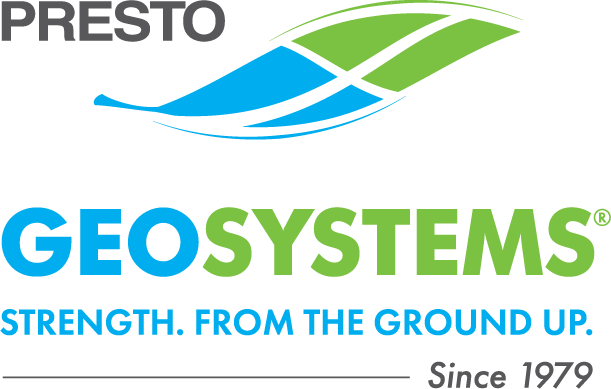Stabilization for Higher-Performing Pavements Ports and intermodal yards in coastal areas are more prone to pavement problems due to inherent soft, unsupportive soils and high water levels. Heavy traffic patterns and the constant weight of loaded parked trailers and stacked containers at these facilities can accelerate the degradation of the paved or unpaved surfaces and subbase materials. The repeated pressure over poor soil conditions results in settlement, ruts, potholes, and even pavement failure. These surface problems require continual, costly maintenance and interruptions to facility operations. But the problem isn’t at the surface—it’s a base stabilization problem. Transforming Base Materials through 3D Confinement Creating and ensuring a stable surface supportive of the long-term, heavy traffic needs starts with better stabilization of the base materials. The GEOWEB® 3D Confinement System is built for this function. The system’s deep, cellular network controls both the horizontal and vertical movement of unstable base soils. When vertical loads are applied, active earth pressures in the loaded GEOWEB® cells push against passive earth pressures in adjacent cells to form a stable system. The benefits of confining fill are applied to both base reinforcement and unpaved surface applications. Permeable Unpaved Pavements Utilizing the GEOWEB® 3D system at the… Read more »
Posts Tagged: geocells
Build a Stronger Foundation for Infrastructure Projects with 3D Soil Confinement
It’s no secret that America’s infrastructure is desperately in need of investment. The American Society of Civil Engineers (ASCE) gave the country’s infrastructure an overall grade of D-plus in its 2017 Infrastructure Report Card—dangerously close to an outright failing grade. The ASCE estimates that the U.S. will need to spend nearly $4.5 trillion by 2025 to fix the country’s roads, bridges, dams, and other infrastructure. Our nation’s roads and bridges—commonly referred to as the “backbone” of the U.S. transportation system—received grades of D and C-plus, respectively. These transportation systems are deteriorating due to advancing age, increasing use, and inadequate funding. This degradation leads to a significant cost to users in terms of time, money, and safety. There are over 4 million miles of road in the United States, and the cost to maintain these roadways can vary greatly by state. Several factors determine maintenance costs, including the type of pavement surface, its current condition, its geographical location, average precipitation, number of annual freeze/thaw cycles, and frequency of use. Three-Dimensional Geocells Provide Solutions to Aging Infrastructure The long-term performance of infrastructure construction projects depends on the strength of the underlying soil. Through an interconnected honeycomb-like network, 3D geocells confine and stabilize… Read more »
Bringing Stability to an Unstable World
With this summer’s extremely wet weather conditions across the country, building access roads is a major challenge. Muddy, soft ground is causing construction delays when it comes to moving heavy vehicles and equipment over the soft soils. Presto’s GEOWEB® Soil Stabilization System offers a way to build roads even with these site challenges using low-cost, local fill—and has been doing so for over 30 years. In fact, the GEOWEB system is the go-to solution for many oil companies in remote areas like the Canadian oil sands and the Amazon basin. Recently, EnergyNow Media featured an article on GEOWEB roads addressing the latest access challenges in the energy sector. The EnergyNow article is republished below. Reprint of recent article written by “EnergyNow Media” (North American Energy Magazine) Presto Geosystems: Bringing Stability to an Unstable World Oil and gas is a tricky business. Everything from resource extraction to site management to processing is fraught with difficulties, challenges, and trials. However, one often-overlooked aspect within this industry is that of simply being able to access the resource site in the first place. Once access is established, it’s crucial that there is a clean, stable platform to work on and transport resources back out…. Read more »
Choosing the Right Geocell
Written By: Bryan Wedin P.E., Chief Design Engineer, Presto Geosystems Not all geocells are created equal. While most manufacturers can provide similar-looking written specifications, you need assurances that the material delivered for your project is of the high quality that you expect. Important factors in the success of your geocell project include: Quality The geocell material is proven, strong, and will last Require only the highest quality virgin High Density Polyethylene (HDPE) resin Low quality or recycled resin can lead to weak and/or inconsistent seam strength, putting the success of your project at risk. Non-HDPE materials cannot match the nearly 40 years of in-ground experience of HDPE geocells and plastic alloy proprietary blends can mask cheap stiff filler materials. ISO Certification Important, but the manufacturer sets the testing protocol for the certification. Require a Certificate of Analysis (COA) for the material that is shipped to your project. An ISO certification that does not require continuous testing is lacking. Integral Components The complete solution includes proper components Non-corrosive, high-strength panel connection method (ATRA® Keys vs. weak staples or zip ties) Anchors that provide secure connections to the geocell (ATRA® stakes vs. J-hooks) Load Transfer Devices for tendon applications that are non-corrosive and… Read more »

 800.548.3424
800.548.3424